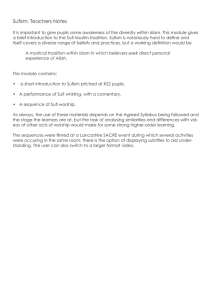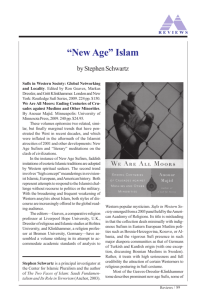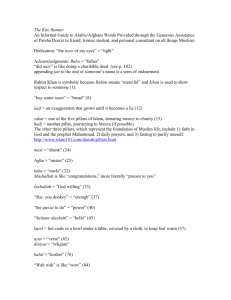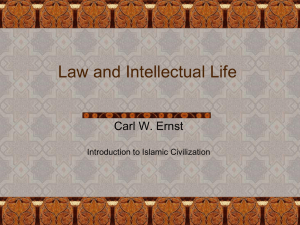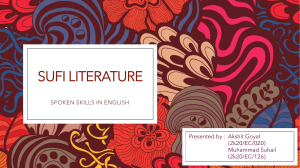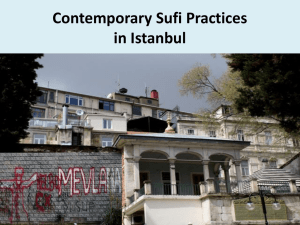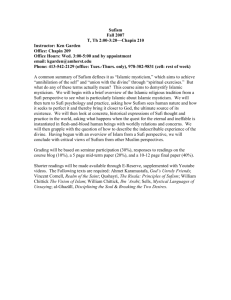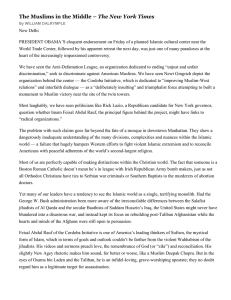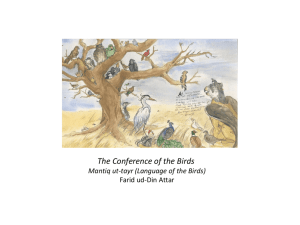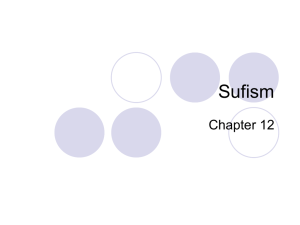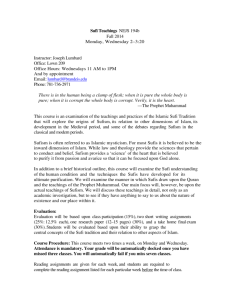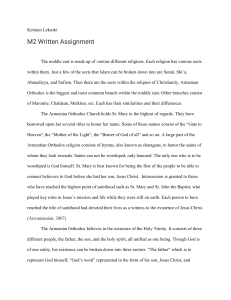Notes
advertisement
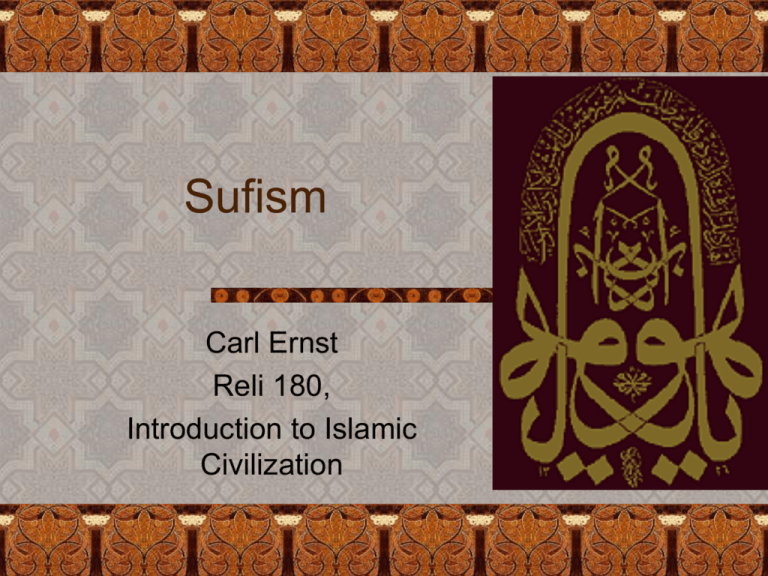
Sufism Carl Ernst Reli 180, Introduction to Islamic Civilization Outline Problems of definition Modern European and fundamentalist concepts of Sufism Quick vocabulary check on Sunni/Shi`I Ibn Khaldun on Sufism Institutional development of Sufism, post 1200 2 1. Definition and the problem of “essentially contested terms” Examples: Liberal; justice; freedom (see George Lakoff, Whose Freedom? The Battle over America's Most Important Idea) Different perspectives on Sufism: foreign & non-Islamic, or the heart of Islam? Where do definitions come from? Summaries of analytical observation (Plato) Historical record (Oxford English Dictionary) Authority (political/religious figures) 3 Arabic definitions The derivations of Sufi suf, wool, garment of ascetic denial Safa’, “purity” safwa, “the elite” Ahl al-suffa, “the people of the bench” (early Muslims who shared everything in common) Tasawwuf, “becoming a Sufi” explained by teaching definitions How might that differ from “Sufism” as part of the catalog of “isms”? 4 2. Rediscovery of the Sufi tradition Spirituality, experience, mysticism: loaded terms from European/Christian history Early Europeans like Sufi poetry (love and wine), thought it couldn’t possibly be Islamic – must be from somewhere else? Recent colonial/postcolonial reformations of Islamic identity (“fundamentalism”) reject Sufi saints, intercession, Sufi lineages and practices, as evil innovations 5 3. Who overlaps with whom? A quick vocabulary check Sunni Sufis, and Shi`i Sufis 6 Human face composed of Allah, Muhammad, Ali 7 4. Ibn Khaldun on Sufism “belongs to the sciences of the religious law that originated in Islam” Divine worship, devotion to God, aversion from the world, abstinence from wealth, retirement into solitude for worship – all common among early Muslims Special name “Sufi” developed a couple of centuries later [compare special technical terms of Islamic law and hadith] 8 Ibn Khaldun: characteristics of Sufism Asceticism Intuitive perception of psychological states and stations Self scrutiny and quest for knowledge and unity with God Special language for inner experience, parallel to other fields of religious knowledge 9 Ibn Khaldun explains Sufism Philosophical psychology as an explanation of Sufi experiences “Removal of the veil” as a key metaphor for perception that goes beyond the senses Different views on God as separate or one with creatures (362); alleged similarity with philosophical and Christian views Disapproval of Sufis by legal scholars (muftis, who give fatwas) 10 Ibn Khaldun criticizes Sufism Theories of absolute oneness: only God exists Theory of cosmic imagination -- dismissed as contrary to reason and experience 11 More criticism of Sufism requires distinction of topics 1. “pious exertions” of meditation and worship 2. Removal of the veil, perception of supernatural realities 3. The operation of divine grace in the world 4. Ecstatic expressions that arouse suspicion (“I am the truth” – Hallaj) These are the primary problem; they should be disapproved or reinterpreted 12 Ibn Khaldun’s final verdict Seeking inner experience is fine, but it’s better not to discuss them publicly! 13 5. Institutional development of Sufism, post 1200 “Saints” or living friends of God Problems with using the term “saint” Tombs as centers of pilgrimage: local forms Masters (shaykh, pir) and disciples (murid) “Chains” (silsila) of master and disciple, going back to the Prophet [Sufi “orders”] “Ways” (tariqa) taught by orders Veneration of the Prophet 14 Tomb of Mu`in al-Din Chishti (Ajmer, India, d. 1235) 15 Tomb of Ahmadu Bamba (Touba, Senegal, d. 1910) 16 Scale of Sufi shrine pilgrimage Ajmer receives 1.5 million pilgrims at the annual festival Touba receives over 2 million pilgrims Neither pilgrimage center is aware of or connected to the other Both challenge the hajj to Mecca in size To what extent should they be considered marginal in modern Islam? 17 More institutional developments Chanting the Arabic names of God as a ritual of remembrance (dhikr) Rituals of music, recitation of poetry Sometimes arms-length from politics, sometimes tightly involved Abolition of Sufism in Turkey by secular govt., in Saudi Arabia by fundamentalists Modern phenomenon of Sufism for nonMuslims 18 Conclusion Problems of definition: “Once Sufism was a reality without a name; now it is a name without a reality” -- Abu al-Hasan Fushanja (11th century) 19
